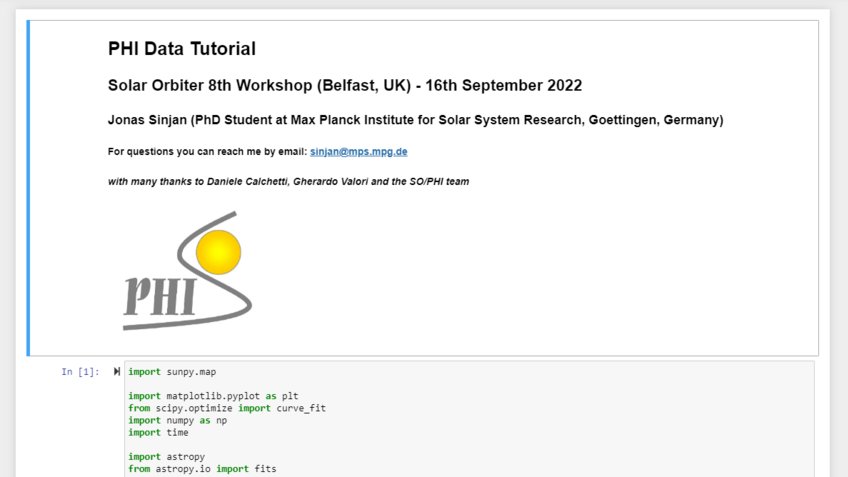
SO/PHI Data Format, Description and Tutorials
Author: Jonas Sinjan
Information about the content of the different FITS files, and tutorials on SO/PHI data usage
Data Products
The data available in the solar archive consists in 7 products:
- icnt: continuum intensity computed by the RTE inversion;
- vlos: longitudinal velocity computed by the RTE inversion;
- bmag: magnetic field strength computed by the RTE inversion;
- binc: magnetic field inclination computed by the RTE inversion;
- bazi: ambiguous magnetic field azimuth computed by the RTE inversion;
- blos: longitudinal magnetic field computed from bmag and binc (note that blos is typically more robust than either bmag or binc);
- stokes: full Stokes vector (I, Q, U, V) measured in 5 points within the absorption line and in one point in the near continuum (measured continuum).
The stokes files consist in fits files with 4 axes: X, Y, Stokes parameter, wavelength. The data from the first data release have a wrong order: wavelength, Stokes parameter, X, Y. This mistake will be fixed in the next version of the data.
Continuum Intensity
We would like to focus you attention on the icnt data product: this data product is computed by the RTE inversion code, but SO/PHI measures the intensity in the near continuum of the Fe I absorption line at ~ ±300 mÅ from the line core. The continuum can be sampled on either the blue or the red side of the line, depending on the orbital constraints.
You can find the measured continuum intensity in these wavelength positions of the stokes data products:
- from 2022-03-03 to 2022-03-30: red
- from 2022-03-30 (only during the Connection Mosaic SOOP) to 2022-04-05: blue
- from 2022-10-12 to 2022-10-16: red
- from 2022-10-17 to 2022-11-02: blue
Data Tutorials
A handy tutorial, is available on Github, in the form of a Jupyter notebook, with helper functions provided in a .py file. It can be launched via binder to simplify the installation procedure.
The PHI tutorial covers:
- Both FDT and HRT
- Loading data from SOAR
- Functionality with sunpy.maps
- Plotting the data products
- Light travel time correction
- Checking whether Image Stabilisation System was operational for a given dataset (HRT only)
- Retrieving the wavelength positions in the L2 Stokes dataset (including the nearby continuum position, measured at ± 300mÅ)
- HRT Stokes V noise estimation
- FDT - HMI & HRT - HMI comparison with sunpy.reproject
The PHI tutorial can be found here: PHI_tutorial or following the link from the card below.
Solar Orbiter Archive (SOAR) Download Example:
Requirements:
- python 3.6+
- sunpy 3.+
- sunpy-soar
- astropy 4.+
For detailed information using the sunpy-soar plugin, please visit: https://pypi.org/project/sunpy-soar/